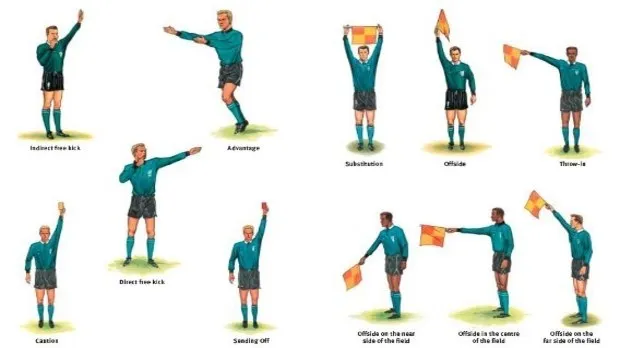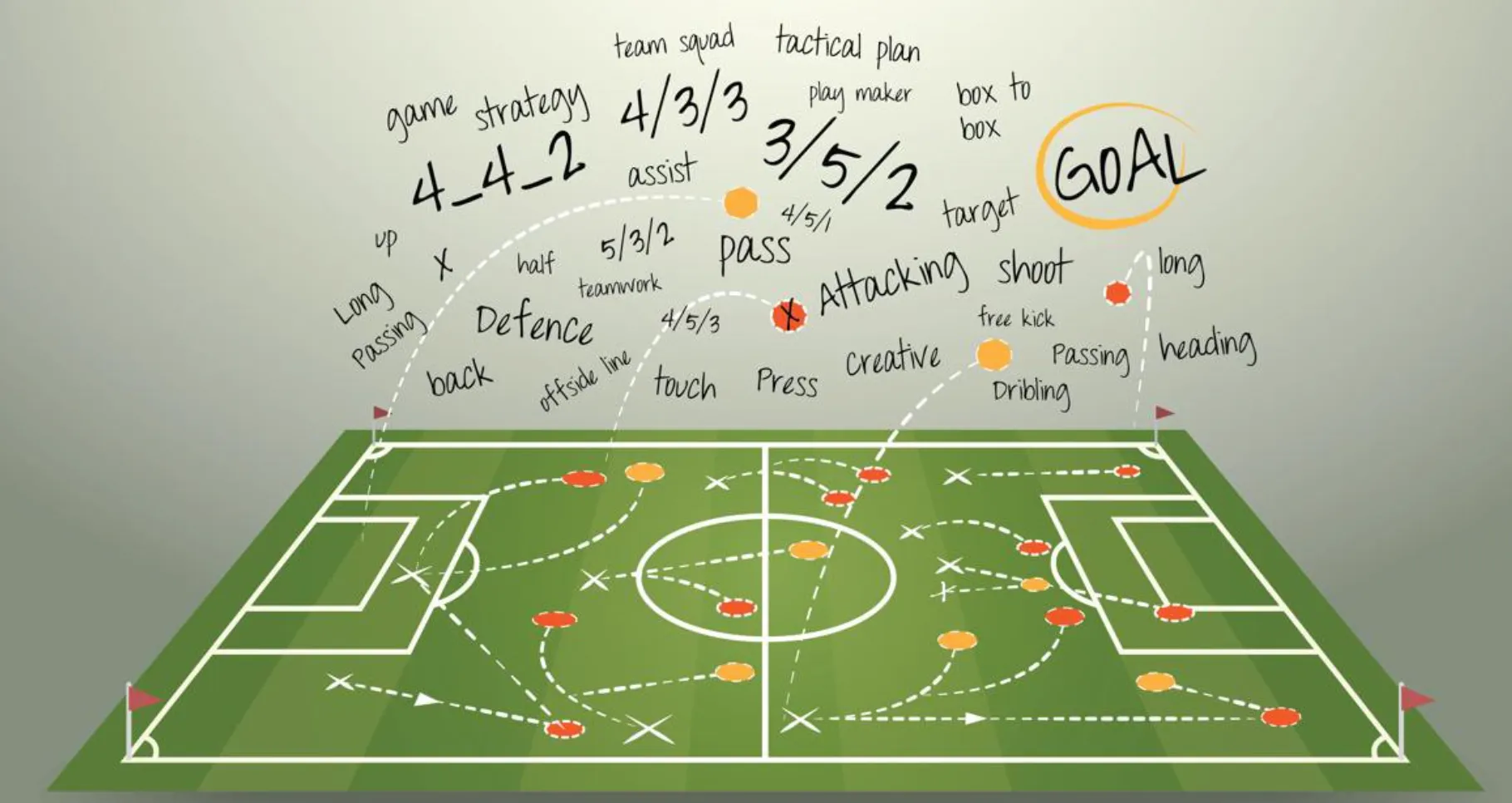
Soccer, also known as football in many countries, is a sport that is loved and played by millions of people around the world. It has a rich history and deep-rooted traditions, making it one of the most popular sports in the world. However, for someone who is new to the game, the terminology used in soccer can be confusing and overwhelming. From offside to free kick, there are many terms that may sound unfamiliar and leave you scratching your head. But fear not, this comprehensive guide will break down all the important soccer terms and help you understand the language of the game.

1. The Basics: Understanding the Fundamentals of Soccer
Before we dive into the different terms used in soccer, it’s important to have a basic understanding of the game itself. Soccer is a team sport played between two teams, each consisting of eleven players. The objective of the game is to score more goals than the opposing team, with a goal being scored when the ball crosses the goal line and goes into the net. The game is played on a rectangular field with two goals at either end. The players can use any part of their body except their hands and arms to move the ball around the field. Now, let’s explore some of the key terms used in soccer.
Positions: Where Each Player Plays on the Field
In soccer, there are different positions that players can play on the field, each with its own specific role and responsibilities. Here are some of the main positions in soccer:
1. Goalkeeper
The goalkeeper, also known as the keeper or goalie, is the player who stands in front of the goal and tries to prevent the opposing team from scoring. They are the only player allowed to use their hands and arms to touch the ball within their own penalty area. The goalkeeper’s main responsibility is to stop shots from going into the net and also to organize and communicate with their teammates at the back.
2. Defenders
Defenders are players who play in front of the goalkeeper and are responsible for protecting their team’s goal. Their main job is to prevent the opposing team from scoring by tackling, intercepting passes, and clearing the ball away from danger. There are different types of defenders, such as center-backs, full-backs, and wing-backs, each with their own specific roles and responsibilities.
3. Midfielders
Midfielders are players who operate in the middle of the field and are responsible for both attacking and defending. They are often considered the engine of the team, as they help to link the defense and the attack. They are responsible for controlling the game and providing passes to their teammates in better positions.
4. Forwards
Forwards, also known as strikers or attackers, are the players who are closest to the opposing team’s goal. Their main job is to score goals by receiving passes from their teammates or creating scoring opportunities on their own. They are typically the most skilled and creative players on the team.
Possession: Who Has the Ball?
Possession is a term used to describe which team has control of the ball. In soccer, possession can shift from one team to another quickly and frequently. The team that has the ball is said to be “in possession” while the team without the ball is said to be “out of possession”. Possession is an important aspect of the game, as the team with more possession usually has more control over the game.
Possession-Based Terms
- Possession: As mentioned earlier, possession refers to which team has control of the ball.
- Dribbling: Dribbling is when a player moves with the ball using short touches with their feet.
- Passing: Passing is when a player kicks the ball to their teammate.
- Receiving: Receiving is when a player successfully controls the ball after it has been passed to them.
- Tackling: Tackling is when a player tries to take the ball away from an opposing player by using their feet to kick the ball.
2. Key Soccer Rules: Understanding the Laws of the Game

To fully understand soccer terminology, it’s important to have a good grasp of the rules of the game. Here are some key rules that every soccer player and fan should know:
Scoring: How Goals Are Scored
Scoring a goal is the ultimate objective in soccer. A goal is scored when the ball crosses the goal line and goes into the net. However, there are certain rules that need to be followed for a goal to count:
1. Offside
Offside is one of the most confusing and debated rules in soccer. If a player is in an offside position (closer to the opponent’s goal than both the ball and the second-to-last defender), they cannot receive the ball from a teammate unless there are at least two opposing players between them and the goal. This rule is in place to prevent players from camping in front of the goal waiting for a pass.
2. Fouls and Free Kicks
Fouls occur when a player uses excessive force or commits an illegal action against an opponent. When a foul is committed, the referee can award a free kick to the opposing team. The team can then either take the kick immediately or wait for the signal from the referee to take the kick.
3. Penalty Kicks
A penalty kick is a type of free kick awarded to a team if a player is fouled inside the penalty area by an opposing player. The penalty kick is taken from the penalty spot, which is 12 yards away from the goal line. The only players allowed in the penalty area during a penalty kick are the taker, the goalkeeper, and the defending team’s players.
Time: How Long Does a Soccer Game Last?
A soccer game is divided into two halves of 45 minutes each, with a 15-minute break in between. However, the referee has the authority to add more time to compensate for any stoppages or delays that may have occurred during the game. This additional time is known as “injury time” or “stoppage time”.
Time-Based Terms
- Half-time: The break between the first and second half of a game.
- Extra time: Additional time added at the end of each half by the referee.
- Injury time/Stoppage time: Time added to compensate for any stoppages in the game.
3. Soccer Equipment: The Essentials for Playing the Game
In order to play soccer, you will need some basic equipment. Here is a rundown of the essential gear needed to play the game:
Balls: The Most Important Piece of Equipment
The most important piece of equipment in soccer is the ball. A regulation soccer ball must be spherical in shape and made of leather or other similar materials. The size of the ball varies depending on the age group and level of play. For example, a size 5 ball is used in professional games, while a size 4 ball is used for younger players.
Different Types of Balls:
- Match balls: These are high-quality, FIFA-approved balls used in professional games.
- Training balls: These are similar to match balls but are cheaper and more durable, making them ideal for practice sessions.
- Futsal balls: These are smaller and heavier than regular soccer balls and are used in futsal, a variation of indoor soccer.
- Beach balls: These are specially designed for playing soccer on the beach, with a softer and lighter construction for easier play on sand.
Clothing: What to Wear When Playing Soccer
Soccer players typically wear a jersey, shorts, socks, and cleats when playing. The jerseys are usually made of lightweight, breathable materials and have the team’s name and number on them. The shorts are also made of lightweight material and have an elastic waistband for better movement. Socks go up to just below the knee and help to keep shin guards in place. Cleats, also known as boots, provide traction and stability on the field.
Types of Cleats:
- Molded cleats: These have rubber or plastic studs molded into the sole of the shoe and are suitable for most playing surfaces.
- Detachable cleats: These have studs that can be removed and replaced with different lengths depending on the playing surface.
- Turf shoes: These have small rubber studs and are designed for artificial turf or hard ground surfaces.
- Indoor shoes: These have flat soles and are used for playing indoor soccer on hard surfaces.
Protective Gear: Keeping Safe on the Field
While not mandatory, wearing protective gear can help prevent injuries during a game. Here are some of the most common types of protective gear worn by soccer players:
1. Shin Guards
Shin guards are worn underneath the socks to protect the shins from kicks and tackles. They are made of either plastic or foam and come in different sizes depending on the player’s height.
2. Goalkeeper Gloves
As mentioned earlier, goalkeepers are the only players allowed to use their hands and arms to touch the ball within their own penalty area. Therefore, they wear gloves to help grip and catch the ball more easily.
3. Headgear
Headgear is commonly used by younger players and those who have recently suffered a head injury. It provides extra protection against head collisions and can also help minimize the risk of concussions.
4. Tactics and Strategies: Understanding How Teams Play

In soccer, teams use different tactics and strategies to try and outplay their opponents. Here are some of the most common tactics and strategies used in the game:
Formations: How Players Are Positioned on the Field
Formations refer to how players are positioned on the field. They are usually represented by a series of numbers separated by dashes, with the first number representing the number of defenders, the second number representing the number of midfielders, and the third number representing the number of forwards. For example, a 4-3-3 formation means there are four defenders, three midfielders, and three forwards.
Popular Formations:
- 4-4-2: This is a classic formation with four defenders, four midfielders, and two forwards.
- 3-5-2: This is an attacking formation with three defenders, five midfielders, and two forwards.
- 4-2-3-1: This is a balanced formation with four defenders, two defensive midfielders, three attacking midfielders, and one forward.
Styles of Play: How Teams Approach the Game
Styles of play refer to the general approach a team takes in a game. Different teams may have different styles depending on the strengths and weaknesses of their players. Some of the popular styles of play include:
1. Possession-Based
Possession-based teams focus on keeping the ball and playing short passes to build up attacks. These teams usually have good technical players who are comfortable with the ball at their feet.
2. Counter-Attacking
Counter-attacking teams focus on defending deep and quickly transitioning into attack when they win the ball back. They often rely on fast, skillful players to run at the opposition’s defense.
3. High Pressing
High pressing teams try to win the ball back in the opposition’s half by putting pressure on them when they have possession. This requires a lot of energy and coordination from the players.
5. The World of Soccer: Understanding the Different Competitions
Soccer is played at different levels, from local recreational leagues to international tournaments. Here are some of the main competitions in the world of soccer:
Domestic Leagues: Competitions Within a Country
Domestic leagues are national-level competitions that take place within a particular country. Some of the most popular domestic leagues include the English Premier League, La Liga in Spain, and Serie A in Italy. These leagues consist of several teams from different cities competing against each other to win the league title.
Domestic Cup Competitions:
- FA Cup (England)
- Copa del Rey (Spain)
- Coppa Italia (Italy)
International Tournaments: Competitions Between Countries
International tournaments are competitions between countries or regions. The most prestigious and well-known international tournament is the FIFA World Cup, which takes place every four years and features the best national teams from around the world. Other notable international tournaments include the UEFA European Championship and the Copa America.
International Club Competitions:
- UEFA Champions League (Europe)
- CONCACAF Champions League (North America, Central America, and the Caribbean)
- AFC Champions League (Asia)
6. Soccer Around the World: Understanding the Global Reach of the Game

Soccer is played and celebrated in almost every corner of the world, making it one of the most global sports. Here are some interesting facts about soccer’s reach:
Popularity: How Many People Play and Watch Soccer?
According to FIFA, there are over 270 million people actively involved in playing soccer around the world, making it the most popular sport in terms of participation. In addition, the 2018 FIFA World Cup final was watched by an estimated 1.12 billion people, making it the most-watched sporting event in the world.
Soccer Culture: The Unique Traditions and Customs
Soccer culture is rich and diverse, with unique traditions and customs that vary from country to country. Here are some examples of soccer culture around the world:
1. Argentina: Passionate Fans and Chanting
Argentinean fans are known for their passion and loyalty towards their teams. They also have a tradition of singing and chanting throughout the game, creating a lively atmosphere in the stadium.
2. Brazil: Samba-Style Play
Brazilian soccer is synonymous with the samba style of play, characterized by creativity, flair, and technical ability. This style of play is deeply ingrained in Brazilian culture and is seen as a way of expressing oneself on the field.
3. Germany: Beer and Bratwurst
In Germany, watching soccer often goes hand in hand with drinking beer and eating bratwurst. Many German fans can be seen enjoying a pint of beer and a sausage while supporting their team.
Conclusion
Soccer is a beautiful game with a language and culture of its own. Whether you are a seasoned player or just starting out, understanding the terminology and rules of the game can greatly enhance your experience as a fan or player. We hope this guide has provided you with a comprehensive understanding of the different terms used in soccer and given you a deeper appreciation for the game. So go ahead, put on your cleats, grab a ball, and hit the field – because now, you speak the language of soccer!


